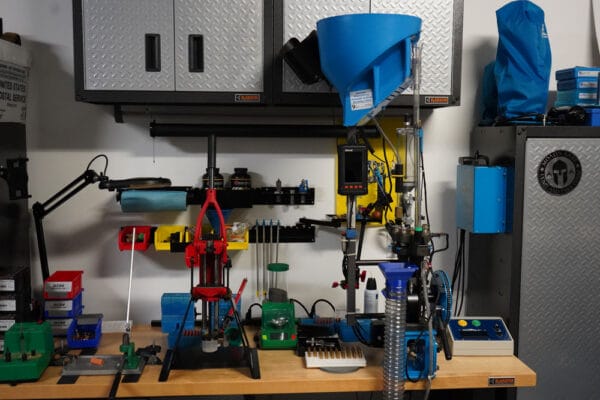
In my first article of this five-part series, I introduced the four different types of reloading presses popular today. If you haven’t read it, it might be worth your while as it’s a decent overall intro to reloading, both the process and the equipment needed.
You will find that, of those four types of presses, three might interest you — unless you want to load right at your shooting bench at the range. That’s a different proposition. If you are talking about bench-mounted presses, you will find that there are single-stage, turret, and progressive presses. Here are the differences:
- Single-Stage presses hold one die at a time. You screw a die into the press, perform that die’s function on all your cases, then switch dies. You will only produce loaded ammo after using the final die of the set.
- Turret presses have a tool head that rotates (either manually or automatically) and holds all the dies at once, usually three or four stations. But you can place only one case at a time in the shell holder. This way, the turret head rotates with each pull of the handle. It takes as many pulls of the handle as you have dies in place to produce a loaded round.
- Progressive presses are different. They use a tool head that holds all the dies, like the turret press. But, they have a rotating shell plate that has as many stations as there are die mounts in the tool head. I own a Dillon Precision XL750 press, where I load 9mm and .223. Since the basic progressive process is much the same for all progressive presses, I will use it as our example.
How Does a Progressive Reloading Press Work?
An empty case drops from the (optional in some cases) electric case feeder down the tube and is shuttled into station 1: the shell holder. You then pull the handle down. The case is resized and deprimed with that one action.
You then pull the handle up and the first case goes to station 2: priming and powder dispensing. Moving the handle up, you will seat the new primer and drop the powder charge in the case.
Station 3 on my press is empty, but that is where a powder check station could go. Move the handle up and down to station 4.
On to station 4 — bullet seating and crimping. After these are done, the handle goes up and down, and the case is moved to station 5, where it is “kicked out” and dropped into an attached collection box for loaded rounds. Remember that, with all the stations occupied, each down/up movement of the handle produces a loaded round.
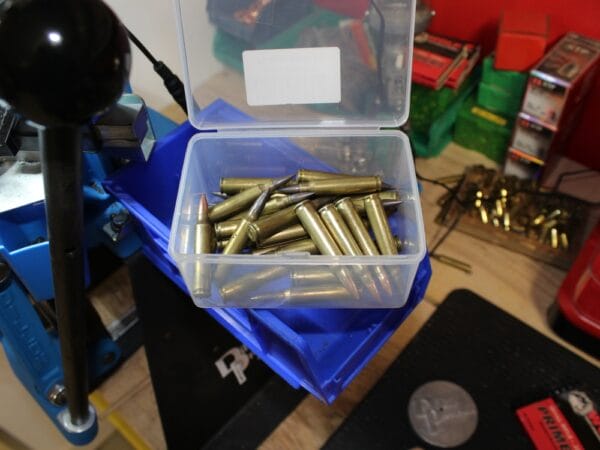
That’s it, in a nutshell. The main difference between a turret press and a true progressive press is that once all the stations are full of cases, the progressive press will produce a loaded round with each handle pull. The turret press requires as many handle pulls as there are stations to produce one round.
A good reloader can load upwards of 500 rounds per hour on a progressive press once all the components are within reach and the press is set up.
So… what’s not to like? Let’s look at a few pros and cons of progressive presses.
Pros
- Speed. Loaded ammo accumulates very quickly
- Strength. Progressive presses tend to be built very strongly
- Rigid. No variations come into play once the press is set – nothing to get out of adjustment
- Automation. Processes like case feeding, powder dispensing, primer seating, etc. tend to be more automated than on other presses
Cons
- Cost. Progressive presses typically cost well more than other types
- Setup. Setting one up is involved and will take some time.
- Glitches. If you get a stuck primer in the feed tube or other issue, your whole operation comes to a halt until you correct it.
The above reflects some general issues that I’ve run into on my Dillon. I admit that I was not exactly an expert when I started with my press, but we understand each other a little better now.
I must admit that, once everything is going, the press’s production is slicker than STP on a glass door knob. It’s easy to crank out dozens of rounds in one sitting. Make sure you have extra primer tubes loaded and ready to go and that your bullets, cases, and powder are handy for refills.
Live Inventory Price Checker

|
Lee Pro 1000 Progressive Reloading Kit For 9MM Luger | Optics Planet | $ 275.89 $ 248.89 |
|
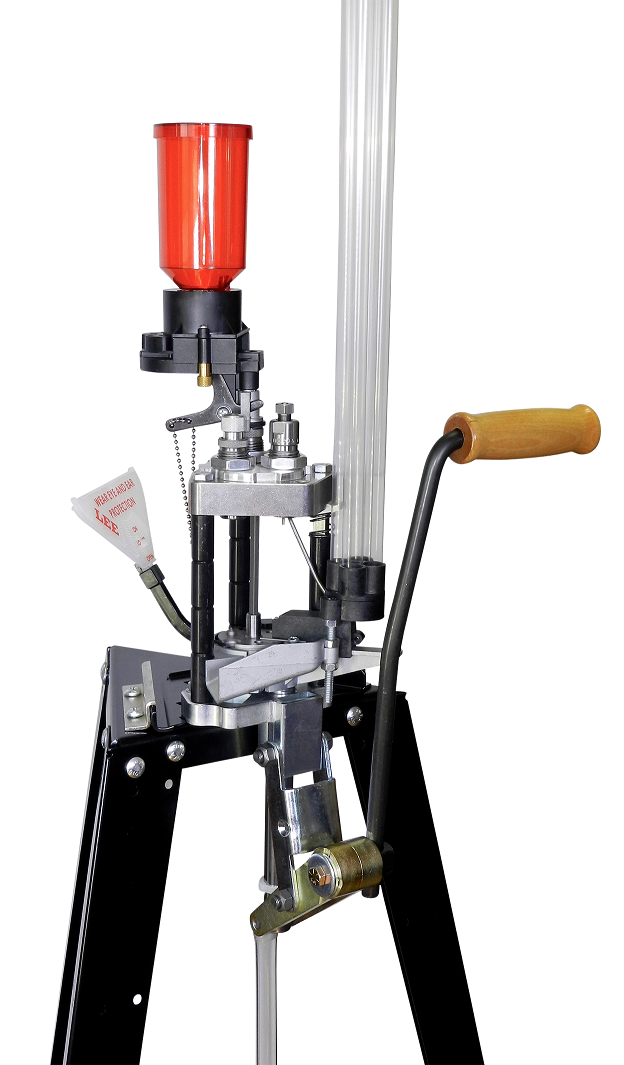
|
Lee Precision Pro 1000 Auto Reloading Kit .38 SPL Progressive Reloading Kit | GrabAGun | $ 194.99 |
|

|
Lee Precision Pro 1000 Progressive Auto Reloading Kit .45 ACP | GrabAGun | $ 212.99 |
|
|
|
Lee Precision Pro 1000 .44 Spl/.44 Mag 3-Hole Progressive Reloading Kit - 90634 | Palmetto State Armory | $ 252.99 $ 224.99 |
|
What You Should Look For In A Progressive Press
I’ve done a lot of research on progressive presses. I own and use one, and I have a few ideas concerning them. I’ve walked the reloading press road since about 1978 and have some years of experience where they are concerned. I say this not to imply that I am the great “Press Guru” or anything of that sort — I’m still learning and make plenty of mistakes. I say it only to show you that I’ve worked a few different press handles up and down for a few decades and have come to a couple of conclusions.
- If you are a brand-new reloader, don’t buy a progressive press. Start with a single-station, or at most, a simple turret press like Lee makes. Progressive presses are wonderful, but they demand a level of knowledge and proficiency that a newbie may not possess. Learn the process first, then add the speed and complexity later.
- Five stations is the minimum number that you should consider. If you decide to seat your bullets on one station and crimp on the next, you will need an extra station. Technically, four should work but I like having options for future operations.
- Consider buying a reloading kit, or at least purchase optional equipment upfront. It can be cheaper to do that. One suggestion I’ll make where kits are concerned has nothing to do with the press itself but concerns the powder scale. Many kits come with balance-beam scales. After reviewing almost 20 scales, I’ve concluded that digital is the way to go. A simple, $35 RCBS Pocket scale will be quicker than a mechanical one.
- When you do “graduate” to a progressive press, watch videos on setting it up. I have the Dillon XL750 and have watched many Dillon Precision videos on YouTube featuring Gary, the Human Manual (as he bills himself). His laid-back approach to all things Dillon Blue was refreshing… but his references to a small-block Chevy V8 get a bit old. (You gotta watch some of his videos!). You can learn a lot by watching instructional videos.
- Lastly, stay organized. I have a problem with doing that… I tend to be messy. A progressive press will demand an orderly approach. Keep bullets, primers, powder, and cases at hand, ready to refill the hoppers or tubes. Also, keep your bench area neat around the press, and make sure you brush away any spilled powder. Also, it would help you to have actual cartridge boxes to put loaded rounds in, not just Ziplock bags.
If you stick with these suggestions, your loading experience will go more smoothly. I had to learn them the hard way. The gist of this is: start small, learn the process, and move up as you can. Stay organized along the way.
Progressive Press Round-Up
Here, I’ve searched for and found several progressive presses from various manufacturers. I list them in price order from low to high. Prices were accurate at the time of writing.
Disclaimers: In terms of Dillon Precision, I have not shown every press they make but “cherry-picked” the models that make a great starter press. They make nine presses in total.
For more info, check the links out below.
Lee Pro 1000 Progressive Reloading Kit (three stations)
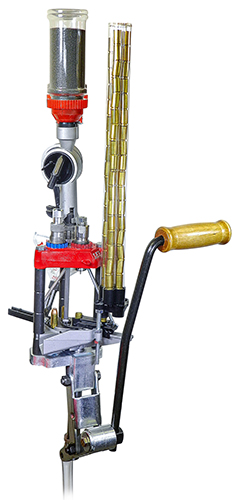
Hornady Lock-n-Load AP (five stations)
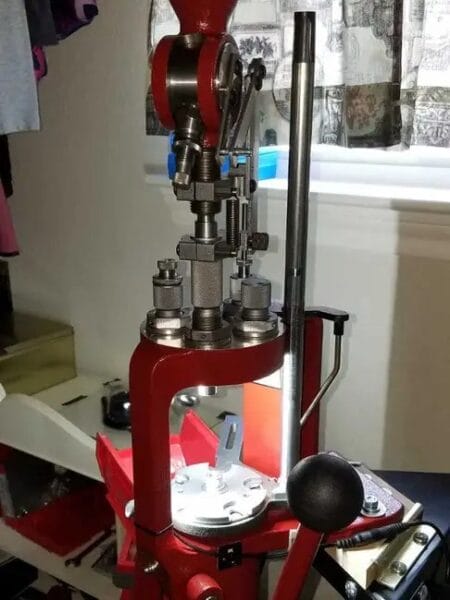
Frankford Arsenal X-10 (ten stations, includes case feeder)
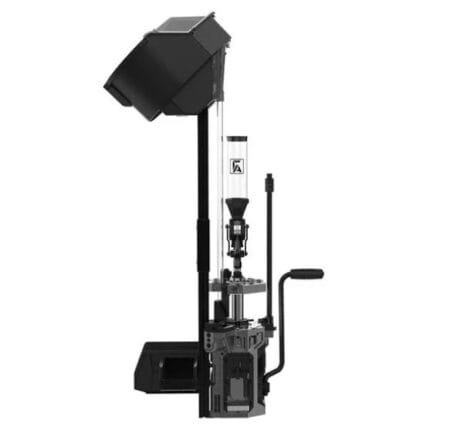
Dillon XL750 (five stations – price includes electric case feeder not shown and other optional accessories (not shown) to make the workflow speedier. This is the set-up I have)
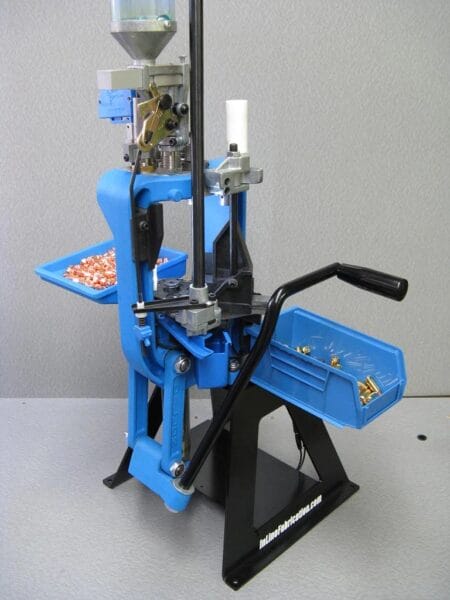
Conclusion
So, you want to move up to a progressive press? Great! You have many choices. As I said above, I’ve shown you some great options, but these are not the only progressive presses out there. After you have figured out what you need, you might consider visiting the links above, reading about the individual presses, watching some videos, and making some decisions.
Regardless of whatever press you end up with, have fun but please follow standard procedures and stay safe as you crank out the ammo. Here’s the benefit of doing so: you will enjoy shooting the baskets of cartridges you’ll make. To answer the question I posed at the very top — yessirree, progressive presses are worth it! Is it time you move up to one?
About Mike Hardesty
With experience spanning over 45 years, Mike Hardesty has long enjoyed shooting and reloading. An inveterate reloader, he casts bullets and reloads for a diverse array of firearms, each handled with long-practiced precision. Living in rural Indiana, his homestead boasts a personal 100-yard range where he shares his love for guns to his four sons, their wives, and eleven grandchildren. As a recognized author, his writings have been featured in notable platforms like Sniper Country, Bear Creek Arsenal Blog, Pew Pew Tactical, TTAG, Dillon Precision’s Blue Press, and Gun Made, revealing his ongoing passion for firearms at the age of 72.

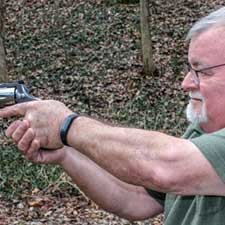
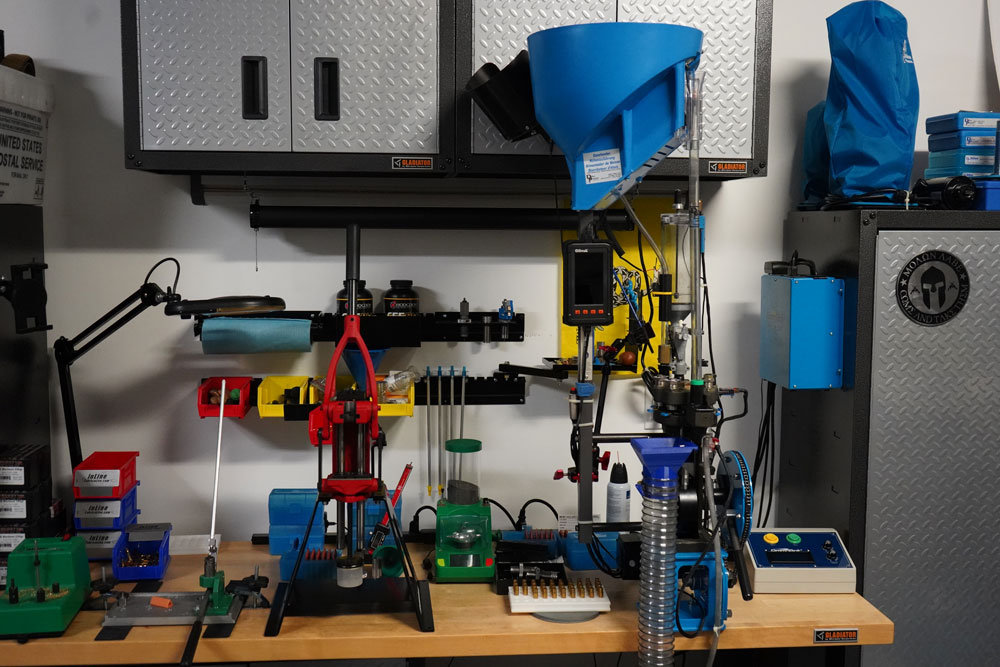




All depends on how much one loads.
I have 5 progressive presses. Right now set up in 3 calibers and 2 gages.
I am well north of a 100 thousands rounds loaded.
I have dies to load around 50 different calibers.
So yes I think progressive presses are well worth it.
I also use my turret and single stage presses a lot.
I used to shoot skeet competitively and would go through about 7,000 rounds (cartridges) a year and would reload about 5,000 of them. Progressive was the only way to go.
Excellent article. As one with both a Dillon RL650 and a Square Deal, I obviously think they’re worth having, but I have two single station presses also. I prefer them for short runs, esp. in big cases like .338 WIN or .375 H&H. I find that the set up time takes me longer than just doing 30-50 rounds or so, one at a time. I do a lot of testing too, ten rounds at a time. Single station is best for those. If I’m doing hundreds at a time, it’s one of the Dillons, depending on whether they’re handgun or… Read more »
I went with a Dillon 550 about 20 years ago and I have been thrilled with it. I call it semi progressive because i have to index the shell plate. The machine does not automatically index it with each pull of the lever. I can operate that as a single state if I like or I can operate it as a semi progressive if I want to. I prefer the mechanical scale because they do not become inaccurate when placed near an outlet. Yes I can probably load 500 cartridges in an hour but I move at a much slower… Read more »
My Dillon 550 spills a lot of powder, and the powder bar is hard to adjust perfectly. Do you have any suggestions?
Wild Bill, I have lusted for Dillions for many years. This admission that they are not the perfect device I imagined will make it easier to be satisfied with my old 3 hole Lee Turret. Thanks !
This spillage issue with Dillon’s powder bar/gravity feed mechanism is an issue that I have not yet solved.
The spillage issue. When is it occurring.
Goin up into the powder feeder?
Coming out of the powder feeder?
Do you have the correct powder drop part in it?
Spillage occurs when I work the handle. The spillage happens when the powder bar slides back and forth. The powder is supposed to gravity feed down into the powder (measuring space) bar, and then slide over to where the measured powder falls down a hole into the shell casing.
Every time the powder bar slides back and forth some powder works its way out, making an under powered cartridge and a mess on the bench.
Yes, I do have the correct parts and it is assembled correctly.
Are you using stick powder? If powder is hanging up in the bar or sticking to the inside of the tube the powder goes into, you can take a static cling dryer sheet and run it around the inside of the tube and through the powder drop and it makes it a little slicker so the powder doesn’t stick or stick as much.
Almost everything I use now is ball. I think the only stick is 4831 and 4064.
Wild Bill, I have an XL650 and have tried many different things to deal with the powder spill issue. I best advice I can give is to keep you Dillon well lubricated. All of the so called fixes that involve various aftermarket parts has only had marginal results. However, on thing that was definitely helpful in powder measure accuracy was the Armanov Clickable Adjustment Knob. That makes adjustments much more accurate. Hope that helps
I am searching for one, right now!!
Ok! Armanove USA. Adjustment knob is on order!
Looks like a great aftermarket tool. I just adjust it over and over until I get the right amount. Using my Chargemaster it only takes a second to see how much the drop is.
Righty tighty is more.
Lefty loosy is less.
CR
That is a cool tool. To bad I own about 5 powder measures but the sight has allot of other cool stuff. Thanks for helping WB.
I attached a ground wire to help eliminate static electricity, too.
The 1st press I bought was a XL650 because I listened to Tom Gresham. He recommended a Dillon if one shot a lot to save time and ammo cost. I was shooting mostly 45Colt & in 2010 the cost for a box was $45 plus 9.5% sales tax. The cost of primers, powder & cast bullets lower the cost/50 was <$10. I quickly add a Lee breech lock single stage press because fixing buggered cartridges is a PITA on a progressive. By the next year I added a case feeder* & modified the powder bar by installing an UniqueTek micrometer… Read more »
I’ve only been reloading for about 1.5 yrs now with a rcbs single stage. I like being able to test charges to find what works best for me and in which firearm (my Ronin Operator 9mm likes a different load than my Beretta APX RDO 9mm, and from different books; Spear and Hornady). I use some rcbs dies and some LEE dies, yes, they are inexpensive and I’ve probably got what I paid for. So I will say this, I’m guessing the dies used are better than mine because none of my Lee dies, for any caliber, will seat a… Read more »
Recommended trouble shoot: Make sure the die thread size is right ones used in your press. Double check everything is tight, locked down and look to see if the die rides up in the holder for some reason. If you load bullets with lube on them the lube will build up on the face of the seating die and cause the bullets to seat deeper each time.
I know what you mean getting that perfect seat. I use all RCBS and have one set of LEE only because it is the only brand that makes it for a specific caliber that I reload for a friend. Suggestion. I have noticed when loading soft point that the lead builds up sometimes in the mouth of the seat tool. Take a look and see if you have build up in there, that will make it very inconsistent. On my 7mm I seat it long and then go back and redo them a little at a time until I get… Read more »
Thanks for your reply. Yes, I’ve taken apart the LEE seating die. My impression is the piece that “floats” inside that die is the culprit; doesn’t come back to the same position each throw, gets hung up. So yes, I do the same as you with sneaking up on it. I don’t seem to have this issue with RCBS dies. I’ve seen the Hornady micrometer crimping die for 6.5 Creedmor and when I buy those dies I will get that one as well. There’s a gentleman in his mid 70’s where I shoot long range. He used an AR or… Read more »
I use 4831 in my 7mm and 4064 in the wifes 243. The Hornady book from 1979 says which round, primer and powder to use for the most accurate shot. I went with that back in 81 and haven’t changed. I have use 4350 in my 7mm because I ran out of 4831 and it worked well too. The little 10x ring is where either of us can put our shots at 100 yards, all three. Usually two touch and the other might be slightly off. Don’t tell my wife, but she is a better shot than me. Stop laughing… Read more »
When SHTF or either going to shoot, reload or baked biscuits…
It appears that you have a bad die. Have you talked to Lee about the problem? They have always provided good support for me (broken depriming pins). Everybody can have a bad part get through (I’ve had that with both Dillon and RCBS – both fully backed their dies and replaced the problem part). It’s always good to try to work with the manufacturer before you start running down their products online.
Another problem I’ve run into with Lee dies is the unbreakable decapping pin they’re so proud of in the ads. It’s unbreakable because it doesn’t seat against anything. It just hangs there, held only in a collet via friction. When a primer is even a little sticky coming out, it just shoves the decapper back up into the die. Then the die has to disassembled and readjusted Every time. It doesn’t take too many of those to become a serious pain in the rear end. Sure they don’t break, because they just collapse instead. Personally, I’d rather break a pin… Read more »
I love my lee non breaking decapping pins.
Save me countless broken ones and time.
But one des have to take a set of wrenches to them to tighten properly.
They cost more than $2 each
I bought six replacements thinking they wouldn’t last.They are longer than the stock ones. And yes, I crank down the collet so there is zero slippage. Haven’t broken a replacement yet.
I’ve occasionally shoved an RCBS decapping pin through a stubborn crimped in military primer. Never broken a pin and never had to take the die apart. They just work. Add in the lack of trimming needed if you’re using their X-die sizer/decapper and you’ll be happy that you spent the extra for the good stuff. Or you can fiddle around with other brands. What is your time worth to you? I understand that Hornady stuff is supposed to be as good as RCBS and they may well be. I’ve never tried a set and can’t say one way or the… Read more »
I solved my Lee decapping pin problem with JB Weld. That did the trick!
After a really bad experience, I swore off Lee products about 20 years ago when i was a teenager, then, about 3 years ago i saw a Lee product i needed for a good price and ordered it… it reminded me exactly why i stopped buying Lee products altogether. Laughable die “locking rings” that consist of a rubber o-ring under the nut, crappy plastic boxes for the dies, paper-thin supporting components for every item, trickler that doesnt work etc. I ended up taking the locking rings off of my unused RCBS dies to replace the Lee die’s locking rings. They… Read more »
I have used RCBS, Dillon, and the Lee 4-.die pistol sets. I like the Lee dies much better than the others for two reasons: (1) the Lee set has a factory crimp die, which I feel is essential for semi-auto rounds, and (2)/the Lee bullet seating die has a micrometers style adjustment knob that let’s me adjust the COL more accurately. I have found zero quality difference comparing Lee dies to the other two brands I have mentioned
Realistically, how many rounds do you typically go through in a given amount of time? A typical hunter will go through 20 rounds or less in a season. Most pistol shooters will go through a 50 round box in an afternoon at the range. In a 3 day “Appleseed” shoot you will go through 350 – 500 rounds in a weekend and feel rode hard and put up wet by Sunday afternoon. Realistically, what kind of shooting do you do? Most people who use a progressive press are loading pistol or small rifle calibers where full length sizing of brass… Read more »
The one issue not discussed, but very important, is speed. Progressive presses allow the reloader to increase production way beyond what a single stage press can accomplish. BTW, suggesting that only 5 stage progressive presses are best is a mistake. Dillon, LEE, RCBS, Hornady all make wonderful 4 stage presses that easily & economically make progressive reloading possible. Is Dillons RL550, 550 rounds per hour not excellent? The only downside to progressive presses is the bigger & faster the production is, the costs to purchase also gets bigger. Plus, expensive fast production machines are hamstrung by constantly reloading primer tubes,… Read more »
I agree with you about the 4 stage presses. In fact, the Dillon 550 will process the largest number of different cartridges of any of Dillon’s presses, making it the most versatile press Dillon makes.
With primers running 10 cents each or more, and other components still high, I can buy new 9mm and 5.56 cheaper than I can reload. One has to have another reason to buy a reloading press of any kind.
SHTF and unavailability of ammo thereafter.
Ammunition control by anti-gunners.
HLB
If you buy practice ammo only, that is true but if you load XTP bullets by Hornady that’s is not true in my case. I can always beat prices on that especially if I use powder, primers and used brass from shooting the cheap stuff from years ago. I can still make 357 XTP HP for about 22 cents a bullet using materials from 13 years ago. 20 Hornady xtphp which I can’t find anymore was about a buck a bullet back then. Now with the new projectiles your looking at about 1.25 a bullet and more. 9mm is the… Read more »
My P08 Luger is a very fussy eater. Off the shelf 9mm that functions flawlessly in my wife’s Beretta 92F turns the Luger into a jam-o-matic. Most off the shelf ammo for 9mm is loaded to give 1150 fps with a 125 grn bullet. Long story short, the Luger simply will not function unless I load it up to 1250 fps. That’s sometimes available as a +P load which is not often stocked. Good luck finding any at Cabella’s or Bass Pro. I still see the toggle not locking open on an empty mag occasionally. Info on the web says… Read more »
Guess you buy new cases. When you refuse your cases, you can reload at a lower cost. An I am getting primers for 6-7 vents each.
I have a single stage and a turret press, both of them get the job done and i feel I have better quality control of the finished product throughout the reloading process.
The magic words: QUALITY CONTROL. Quality control is essential in reloading. The alternative is a potentially damaged firearm and/or injury to the shooter and anyone nearby. Quality control is the one place where a single stage press shines in comparison to a progressive. After I size and prime 50 cases I have 50 cases in the block, head up, so that I can do a quick visual check for missing primers or primers in backwards. Both can and do happen to the best of us. After I charge 50 cases, I have 50 cases in the block neck up so… Read more »
Hi Mike. I realize this was posted a while ago and thanks for your response as well as the article. I like your station but I was wondering, will you ever go up to the RL 1100 or higher and do it all with a fully auto press? Have you ever used one? I don’t think the money spent is really worth it for someone that only shoots about 1,000 rounds a year of 4 or 5 different calibers but that doesn’t mean I wouldn’t want one. Kind of like a Ferrari, I don’t need one but why not if… Read more »
Ok, great article. One suggestion. I use a RCBS charge master, the first one they came out with. Makes sure the AC or heat is off or block the vent. You can breathe on it and make it change and your fan can too. I have a pharmaceutical scale for my hunting rounds that goes to .001 but it is not necessary. One more bit of advice. If you are using your auto powder dispenser to load individual rounds, make sure that the scale has gone through the complete check and shows the weight and the little arrow points towards… Read more »
Good reply, Musicman44. I like your handle… i was a music teacher, trumpet/piano player and shoot 44s. Again, good points. When I reviewed those 15 reloading scales, I found out that they could be variable so care must be taken. Thanks for writing.
Well thank you for taking the time for the complement. It’s nice to know when someone appreciates you and visa versa.
Keep up the good work.
To my one follower that has three accounts or if he only has one, to the three people that down vote me on everything I say. You missed a few, you need to go back and downvote them so I have my usual three. If you don’t I will be disappointed and concerned that your MDS Musicman44mag Derangement Syndrome is slipping. I already know you live in a childish world so I am not concerned about your ignorance or childlike manner but if you forget me, I might not have anything to look forward to everyday. Thank you for keeping… Read more »
ROFL
Some of your missing down votes might be due to others up voting your posts. So you might be coming down a little harshly on your “fan club.”
Hopefully you haven’t damaged their fragile “feels.”
🙂